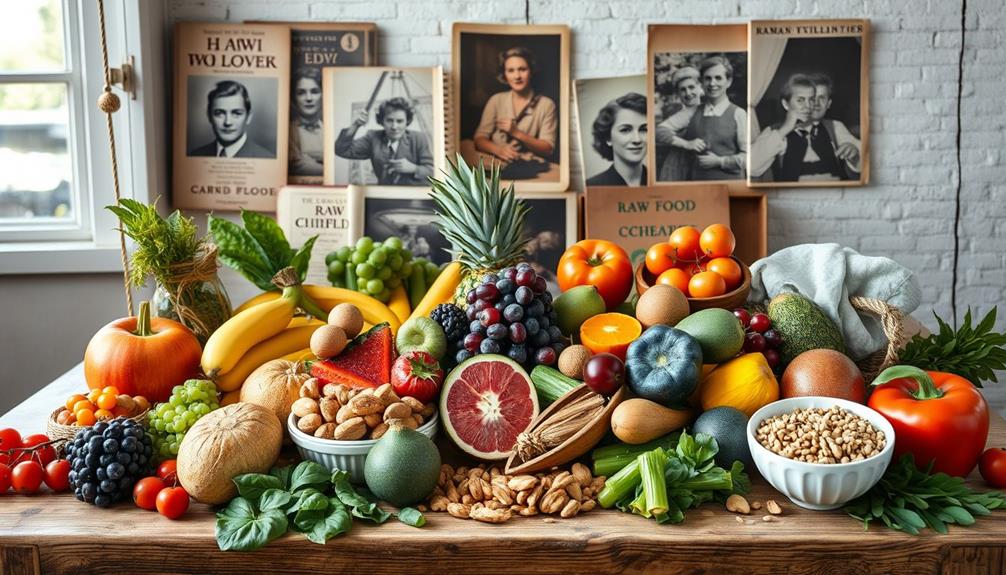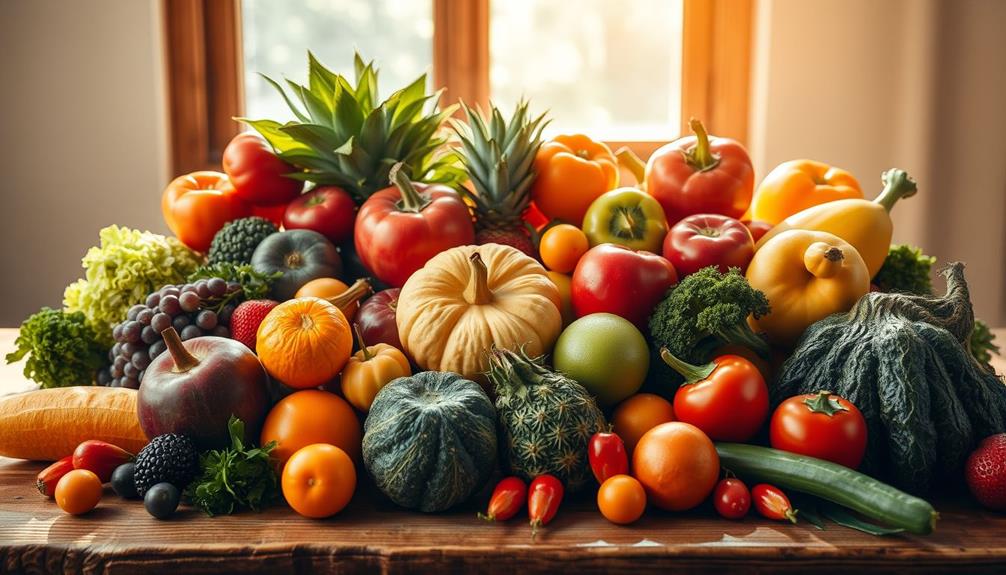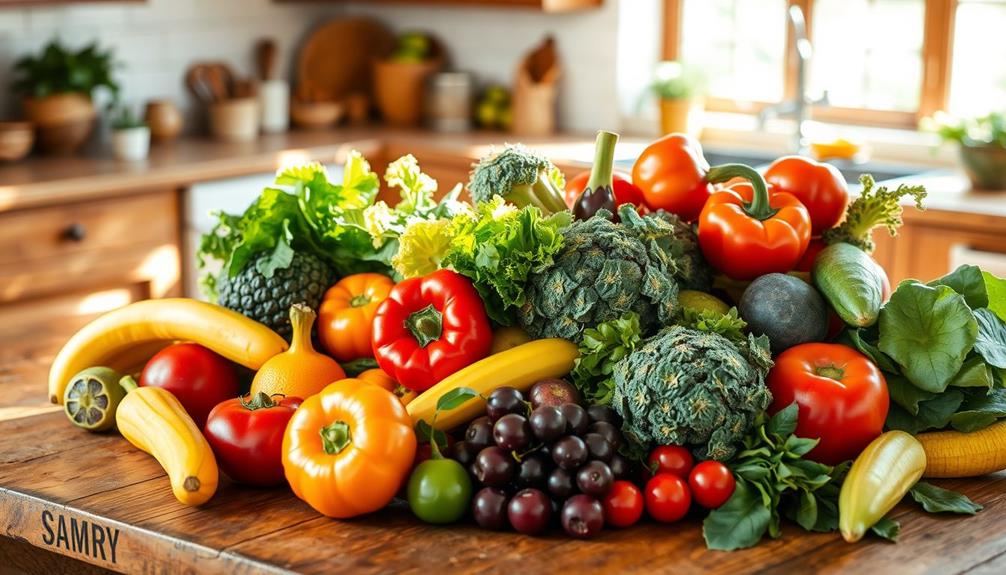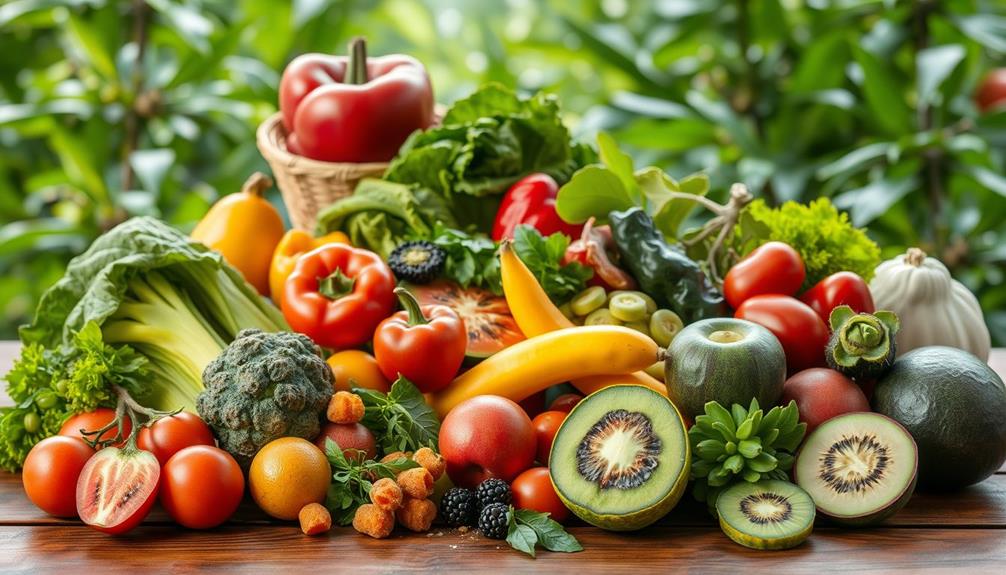The raw food diet really took off in the 1930s, thanks to health advocates like Ann Wigmore promoting the benefits of uncooked foods. They showcased how these diets could restore health and energy. This movement gained even more popularity in the 1980s and 1990s, fueled by celebrity endorsements and the rise of health food stores. With stars like Demi Moore embracing raw foods, the lifestyle became trendy and accessible. Today, interest continues to grow, reflecting a shift toward health-conscious eating. To uncover more about its evolution and modern trends, just look a bit deeper.
Key Takeaways
- The raw food diet's roots trace back to prehistoric times and gained traction in the 1800s through advocates like Maximilian Oskar Bircher-Benner.
- Interest surged in the 1930s due to the Natural Hygiene movement, led by figures like Ann Wigmore and Herbert Shelton.
- The 1980s and 1990s saw significant popularity, fueled by health advocates claiming cancer-fighting properties and celebrity endorsements.
- Key publications, such as Leslie Kenton's "Raw Energy," contributed to the movement's growth during the 1980s and 1990s.
- The rise of raw food restaurants and community events in the late 20th century helped solidify its popularity and accessibility.
Origins of Raw Foodism
The journey of raw foodism stretches back to our prehistoric ancestors, who thrived on uncooked foods long before mastering fire. These early humans instinctively understood the nutritional value of raw ingredients, laying the groundwork for what we now recognize as raw food diets.
As time passed, the concept evolved, gaining traction in the 1800s when Swiss physician Maximilian Oskar Bircher-Benner began promoting the consumption of uncooked foods for their health benefits at his sanatorium. Raw fruits and vegetables are known to be rich in antioxidants and vitamins, which contribute to overall health and well-being.
By the early 20th century, advocates like Eugene and Mrs. Christian emphasized the restorative potential of raw diets in their 1904 publication, "Uncooked Foods and How to Use Them." This focus on the health benefits of raw ingredients sparked renewed interest, particularly in the 1930s with pioneers like Ann Wigmore and Herbert Shelton, who championed the Natural Hygiene movement. Their promotion of single food type meals showcased how uncooked foods could enhance well-being.
The raw food diet would later gain significant popularity in the 1980s and 1990s, partly thanks to celebrity endorsements and the rise of raw food restaurants, further solidifying its place in modern dietary trends.
Early Advocates and Influencers
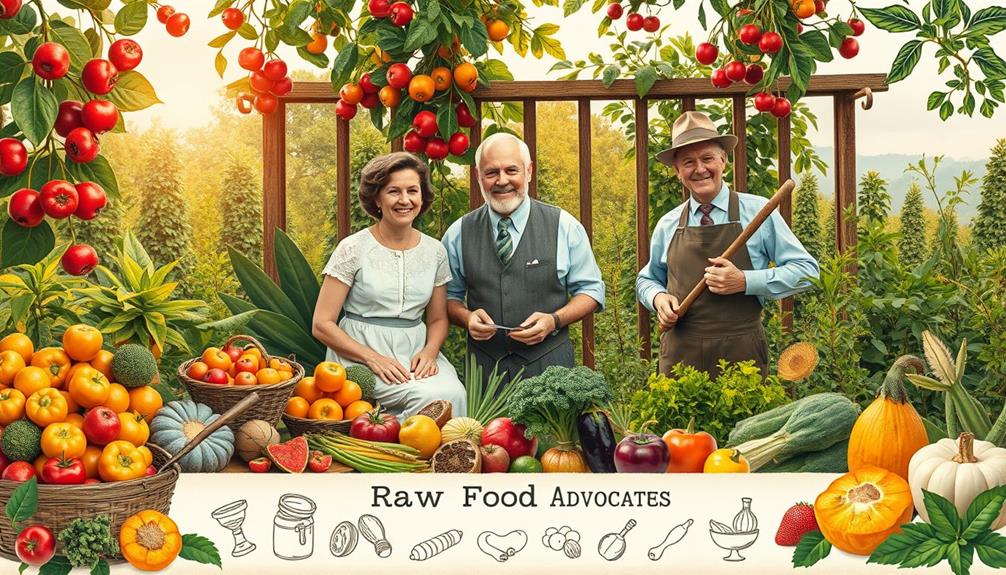
Pioneers of raw foodism like Maximilian Oskar Bircher-Benner and Ann Wigmore shaped the movement with their innovative ideas and practices. They laid the groundwork for what you now recognize as the raw food diet.
Bircher-Benner, a Swiss physician, opened a sanatorium in the early 20th century where he championed the health benefits of raw foods and introduced muesli as a staple dish. This approach encouraged many to explore the advantages of uncooked ingredients, much like how vital oils can provide natural remedies for various health issues, including essential oils for toothache relief.
- Ann Wigmore emphasized the importance of "living foods," promoting wheatgrass juice as a health tonic.
- The 1904 book "Uncooked Foods and How to Use Them" by Eugene and Mrs. Christian highlighted the potential of raw foods for health restoration.
- By the 1980s, the raw food diet gained traction as a supposed cure for various ailments, though major health organizations didn't support these claims.
These early advocates and influencers played significant roles in spreading awareness about the raw food diet, influencing generations to embrace the idea of consuming uncooked, natural foods for better health.
The 1930s Surge in Popularity

A surge of interest in raw food diets emerged in the 1930s, fueled by advocates like Ann Wigmore and Herbert Shelton, who championed the principles of Natural Hygiene. During this decade, you'd notice a significant shift towards the consumption of raw foods, primarily raw fruits and vegetables, emphasizing their health benefits.
The introduction of single food type meals became popular, promoting the idea that eating whole, unprocessed foods could enhance your well-being. Additionally, this period coincided with a growing awareness of the importance of nutrition, paralleling trends in other health movements, such as various brewing methods that emphasize the benefits of quality ingredients.
As industrially processed foods gained popularity, the raw food movement offered an alternative that resonated with many. Health enthusiasts began embracing the concept of "living foods," which are packed with enzymes and nutrients essential for peak health. This newfound awareness aligned with a broader understanding of nutrition and well-being, ultimately driving the demand for raw foods.
The 1930s laid a strong foundation for the raw food diet we see later in the 1980s and 1990s, where celebrity endorsements would further propel this trend into the mainstream. By prioritizing raw foods during this time, you can appreciate how the seeds of the raw food movement were sown, influencing generations to come.
Raw Food Diet in the 1980s

In the 1980s, interest in the raw food diet skyrocketed, driven by health advocates promoting its potential cancer-fighting properties. Although major health organizations didn't support these claims, the allure of a natural, unprocessed lifestyle captivated many.
You likely noticed the rise of raw food restaurants and health food stores during this decade, reflecting a broader cultural shift toward health consciousness.
- Influential figures like Ann Wigmore championed wheatgrass and holistic health practices.
- Leslie Kenton's book, "Raw Energy," became a cornerstone resource for those curious about raw food diets.
- The natural foods movement embraced alternative health practices, solidifying the raw food diet's appeal.
As you explored this new dietary trend, you may have encountered a community passionate about the benefits of raw foods.
The 1980s marked a significant turning point, where the raw food diet began to take root in mainstream culture. With a growing number of advocates and resources, interest in raw foodism flourished, setting the stage for future developments in the decades to come.
Celebrity Endorsements in the 1990s
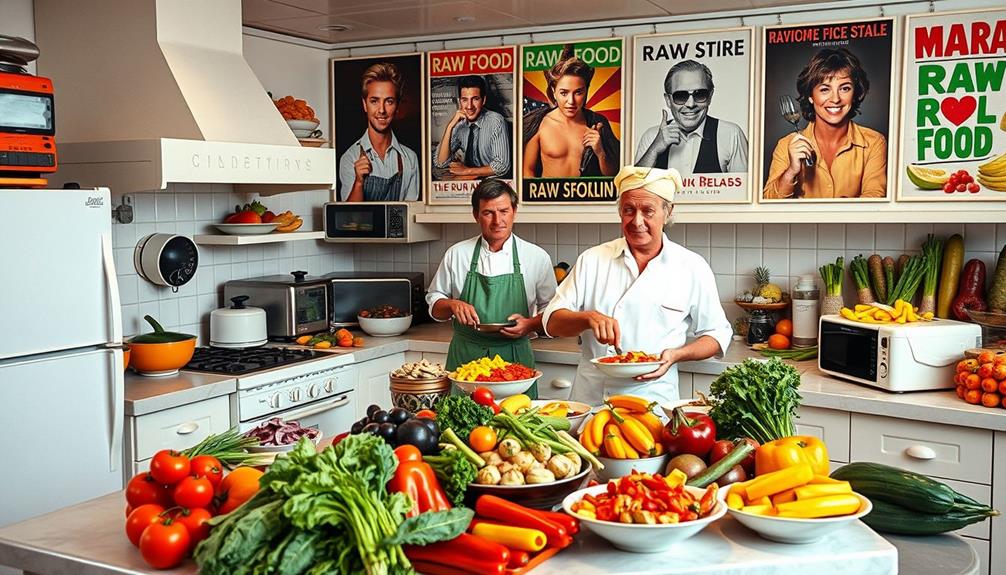
In the 1990s, you couldn't ignore the impact of celebrity endorsements on the raw food diet's popularity.
Stars like Demi Moore and Woody Harrelson not only embraced this lifestyle but also helped push influential diet books into the spotlight. Their adoption of raw foodism aligned with a growing interest in wellness and health, leading to a surge in emotional reflections on the impact of a mother's love within the community.
Media coverage further amplified their influence, making raw foodism a trendy choice for health-conscious individuals everywhere.
Celebrity Influence on Trends
Celebrity endorsements in the 1990s propelled the raw food diet into the spotlight, making it a trendy choice for health-conscious individuals. With celebrities like Demi Moore and Woody Harrelson openly discussing their raw food lifestyles, the diet gained significant traction and became a part of popular culture.
Additionally, many of these celebrities have also embraced other health trends, such as drinking herbal teas like chamomile and ginger, which can alleviate menstrual discomfort and promote relaxation herbal teas like chamomile. This celebrity influence not only elevated the visibility of the raw food diet but also positioned it as a desirable lifestyle associated with wellness and liveliness.
- Raw food restaurants emerged in major cities, often filled with celebrity patrons.
- Books and documentaries featuring famous advocates began to shape public interest.
- The raw food diet became synonymous with contemporary health trends.
The establishment of these restaurants made raw food more accessible, encouraging even more people to adopt this lifestyle.
As celebrities embraced the raw food diet, they created a ripple effect, inspiring their fans to explore healthier eating options. The combination of celebrity advocacy and increasing public awareness helped solidify the raw food diet's place in the health trends of the 1990s, influencing dietary choices for years to come.
Popular Diet Books Released
The rise of the raw food diet in the 1990s wasn't only fueled by celebrity endorsements but also by the release of influential diet books that captured the public's interest. Bestselling titles like "Raw Food/Real World" by Matthew Kenney and Sarma Melngailis provided practical recipes and insights, making the raw food diet accessible to many.
These popular diet books highlighted the health benefits associated with consuming uncooked and unprocessed foods, such as detoxification and weight loss, which resonated with a health-conscious audience. Additionally, the emphasis on budgeting for healthy eating encouraged more individuals to explore this nourishing lifestyle without breaking the bank.
As you explored these books, you likely found yourself inspired by the vibrant dishes and the promise of improved well-being. The authors promoted a lifestyle centered on fresh fruits, vegetables, nuts, and seeds, encouraging readers to embrace this health-oriented movement.
The combination of engaging literature and celebrity advocacy created a buzz that propelled the raw food diet into mainstream culture. With raw food restaurants popping up and raw food festivals gaining popularity, this dietary approach became a community-driven phenomenon.
The 1990s truly marked a significant moment, as these popular diet books played an essential role in shaping the raw food diet's legacy.
Media Coverage and Awareness
While many trends come and go, the raw food diet found a lasting foothold in the 1990s, thanks in large part to influential endorsements from celebrities. These endorsements brought significant media coverage, elevating the raw food diet's profile and appealing to health-conscious individuals.
Celebrities often showcased their own journeys to wellness, similar to how Paula Deen's Wedding Highlights emphasized Southern culinary traditions, drawing attention to the importance of healthy and flavorful food choices.
- Demi Moore and Woody Harrelson championed the diet, drawing their fans' attention.
- The rise of raw food restaurants in major cities made this lifestyle more accessible.
- Books and documentaries released during this time helped demystify raw foodism.
As celebrities embraced the raw food diet, their followers became curious, leading to increased interest and acceptance. Media outlets began to highlight the diet as not just a food choice but a trendy lifestyle, often linking it to the broader wellness and fitness movements.
This strategic media coverage showcased the raw food diet's perceived health benefits, its appeal to those wanting to improve their well-being, and its eco-friendly aspects. The 1990s marked a turning point where celebrity endorsements transformed the raw food diet from a niche practice into a mainstream phenomenon, influencing countless individuals to explore this vibrant and healthful way of eating.
Modern Interpretations and Trends
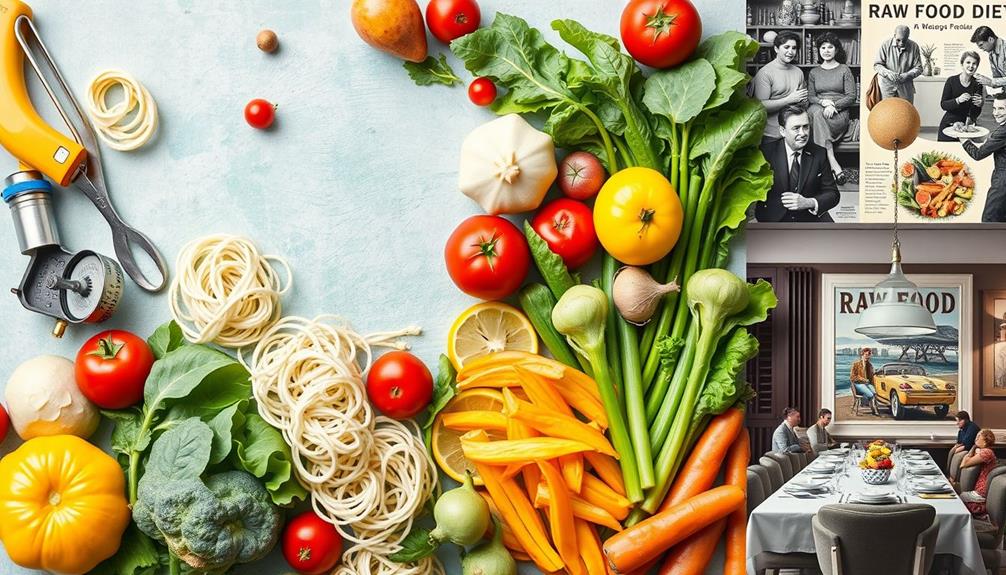
Many people today are rediscovering the raw food diet, integrating it into their lifestyles as a way to enhance overall health and well-being. This resurgence can be traced back to the 1990s when celebrity endorsements began to play a significant role in popularizing the diet. Influential figures showcased the benefits of raw foods, making it more appealing to a broader audience.
As a result, the raw food diet gained mainstream acceptance, paving the way for an explosion of raw food restaurants and cookbooks. The diet's appeal is further heightened by its emphasis on sustainability, as it encourages the use of local and seasonal produce and reduces reliance on processed foods.
In the 2010s, social media took this trend to new heights. Platforms like Instagram and Pinterest became hubs for sharing vibrant raw food recipes, health tips, and personal success stories. You might find vibrant smoothies, zoodles, and colorful salads filling your feed, inspiring you to try your hand at raw cuisine.
The trend's appeal lies not only in its health benefits but also in its emphasis on fresh, unprocessed ingredients.
Today, people are interpreting the raw food diet in various ways, from strict adherence to more flexible approaches that blend raw and cooked foods, allowing for a personalized experience that suits individual preferences.
Cultural Impact on Diet Choices
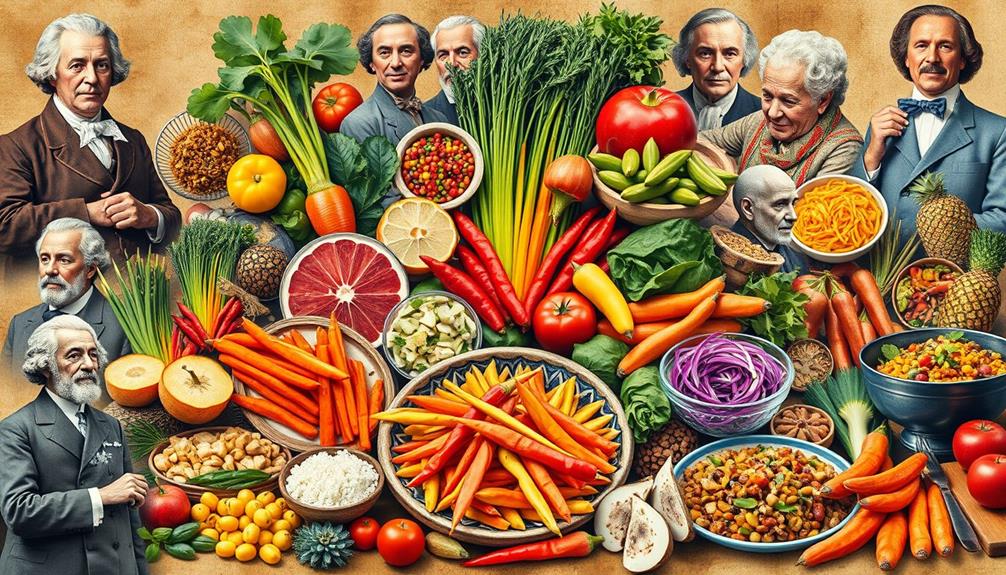
Cultural beliefs and practices greatly shape your diet choices, especially regarding the raw food movement. The raw food diet isn't just about what you eat; it reflects a lifestyle anchored in the perception of health and purity. Many people are increasingly drawn to the idea of consuming foods in their most natural state, which aligns with the growing interest in cold medications overview and holistic health solutions.
Raw foodism challenges traditional cooking methods. It emphasizes the health benefits of consuming uncooked foods. Social media has created a vibrant community around raw eating.
In the early 20th century, figures like Eugene and Mrs. Christian popularized raw food consumption as a means for health restoration. By the 1930s, Maximilian Bircher-Benner's sanatorium showcased raw foods, elevating their status in health circles.
The 1980s saw a resurgence, driven by celebrity endorsements and health publications that framed raw foodism as a remedy for various ailments. These cultural beliefs around food preparation encourage many to perceive raw food diets as more natural and beneficial.
Social media platforms have amplified this shift, fostering a community of health-conscious individuals who share tips and recipes. Ultimately, your dietary choices are influenced not only by personal preferences but also by the cultural narratives surrounding food and health.
Ongoing Debates and Controversies
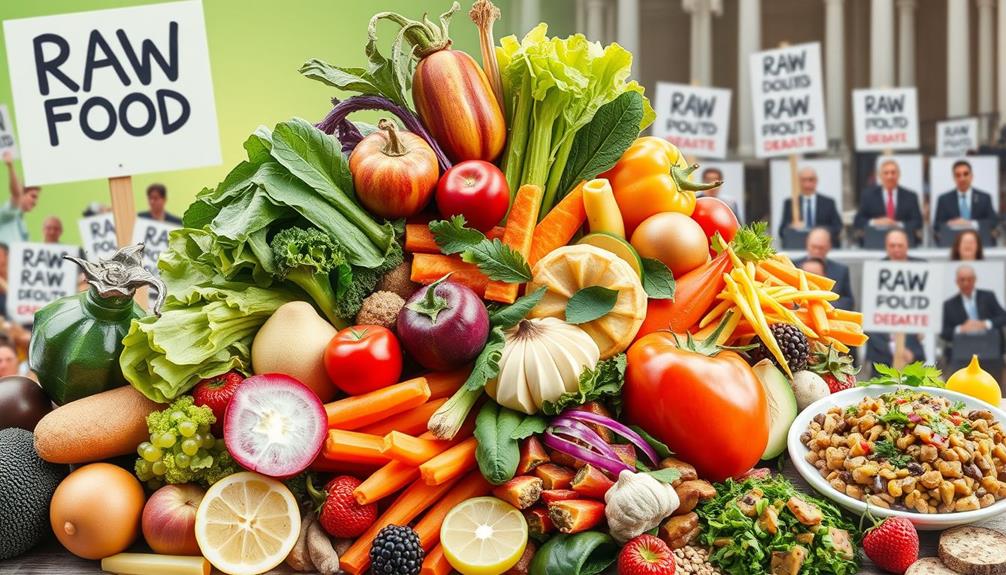
The raw food diet has sparked ongoing debates and controversies, especially regarding its health claims and nutritional adequacy. Since its rise in popularity in the 1930s and later in the 1990s, advocates have touted benefits like cancer prevention and improved energy.
However, major health organizations have criticized these claims, citing a lack of scientific evidence to support them. Some advocates may also experience intense emotional responses similar to those seen in individuals with Borderline Personality Disorder, where emotional fluctuations can impact overall well-being.
You might wonder about the risks of a raw food diet. Critics highlight the restrictive nature of this eating plan, which can lead to nutrient deficiencies, particularly in protein, calcium, and vitamins B12 and D.
The British Dietetic Association has classified the raw food diet as a fad diet, ranking it among the worst celebrity diets due to its potential health risks and imbalanced nutrition.
Frequently Asked Questions
When Did the Raw Food Diet Begin?
The raw food diet began long before recorded history, with early humans eating uncooked foods. However, modern interest sparked in the 1930s, driven by advocates promoting its health benefits and natural principles. To this day, the raw food diet continues to be a popular lifestyle choice for many people seeking to improve their health and increase their consumption of nutrient-dense foods. Proponents of the raw food diet believe that cooking can destroy essential enzymes and nutrients, leading to a less nutritious diet overall. As a result, followers of the raw food diet focus on consuming a variety of fruits, vegetables, nuts, and seeds in their natural, uncooked state.
Why Has the Raw Food Diet Become Popular?
Imagine a garden thriving under the sun's embrace; that's why you crave the raw food diet. It promises liveliness, energy, and health, drawing you in with the allure of nature's untouched bounty. You can't resist!
Did Ancient Humans Eat Raw Food?
Yes, ancient humans primarily ate raw food, foraging fruits, vegetables, nuts, and raw meats. Their diets relied on these natural sources, which provided essential nutrients before the advent of cooking and processed foods.
Are There Any Famous People Advocating for the Raw Food Diet?
Yes, there're several famous advocates for the raw food diet. Celebrities like Demi Moore and Woody Harrelson promote it, while influential chefs like Matthew Kenney elevate raw cuisine, making healthy eating more appealing and trendy.
Conclusion
To sum up, the raw food diet's journey has been like a river, flowing through various cultures and eras, shaping and reshaping our understanding of health. From its early roots to the modern trends, it's clear that this diet has sparked conversations around nutrition and wellness. As you explore these options, remember that what you choose to fuel your body with can greatly impact your overall well-being. So, embrace the journey and find what nourishes you best.

